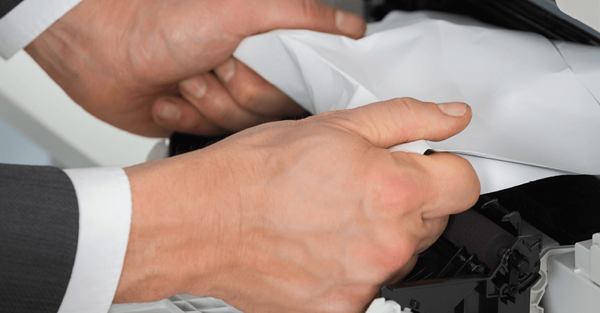
WHAT CAUSES PAPER JAMS?
 Printer technology has come a long way. Today’s printers are faster, quieter and can do more things than they could 20 years ago. However, they still face some of the same issues that they did 20 years ago as well.
Printer technology has come a long way. Today’s printers are faster, quieter and can do more things than they could 20 years ago. However, they still face some of the same issues that they did 20 years ago as well.
Printer paper jams are easily one of the most common printer problems. Paper jams are indiscriminate – they happen on bargain printers and they happen on the most expensive printers. Technology, unfortunately, cannot (yet) overcome some of the basic issues that cause paper jams.
Loading paper incorrectly
This is the number one cause of paper jams. When you send a print job to the printer, it is expecting the size, weight, and finish of the paper to match what you told it you were using. If it expects one thing, but gets another, it can cause a jam. Don’t mix multiple types of paper in a single stack. This can confuse the printer and will almost certainly result in printer paper jams.
You should also be mindful of some issues that arise when you load the paper. Some papers – especially lightweight papers – tend to stick together, and when they run through the printer they can jam. You should always fan the stack of paper that you’re about to put in the input tray. This is done to loosen any sheets that may be stuck together.
Similarly, folded or frayed paper can cause jams. Overloading will also result in paper jams as the rollers are designed to pick up sheets from a particular height. Pay attention to the paper as you load it and keep an eye out for these issues.
Roller damage
Printer rollers pull the sheets from the input tray into the printer. They are designed to grab any kind of paper, yet also do so without damaging or marking the paper. Even though they are designed to last, over time rollers can become worn and might not work as well as they once did – especially under heavy use. Excessive use of specialty papers can also cause rollers to lose some of the functionality.
Use of low-quality paper
 Printers are sensitive devices and can not only be damaged by the usual mishandling, but also by smaller things that may escape your attention. Low quality paper can leave behind what technicians call “paper dust”, which are very small paper bits that only become a problem when they accumulate. Low quality papers also have a greater tendency to tear or become damaged as they pass through the device, or might even be damaged to begin with due to lack of quality control by the manufacturer.
Printers are sensitive devices and can not only be damaged by the usual mishandling, but also by smaller things that may escape your attention. Low quality paper can leave behind what technicians call “paper dust”, which are very small paper bits that only become a problem when they accumulate. Low quality papers also have a greater tendency to tear or become damaged as they pass through the device, or might even be damaged to begin with due to lack of quality control by the manufacturer.
Running regular printer cleaning cycles is beneficial because it keeps the paper pathway clean.
Use of low-quality cartridges
Just as low-quality papers can leave behind paper dust, low quality cartridges can leave behind stray ink and toner. This will not only result in paper jams but also affect output quality. Discount cartridges are cheaper for a reason – they wear out quicker and their manufacturing standards are lower. Refer to your user’s manual, or ask your managed service provider, which cartridges are recommended for your particular device.
Return to the Tech Trends Newsletter
